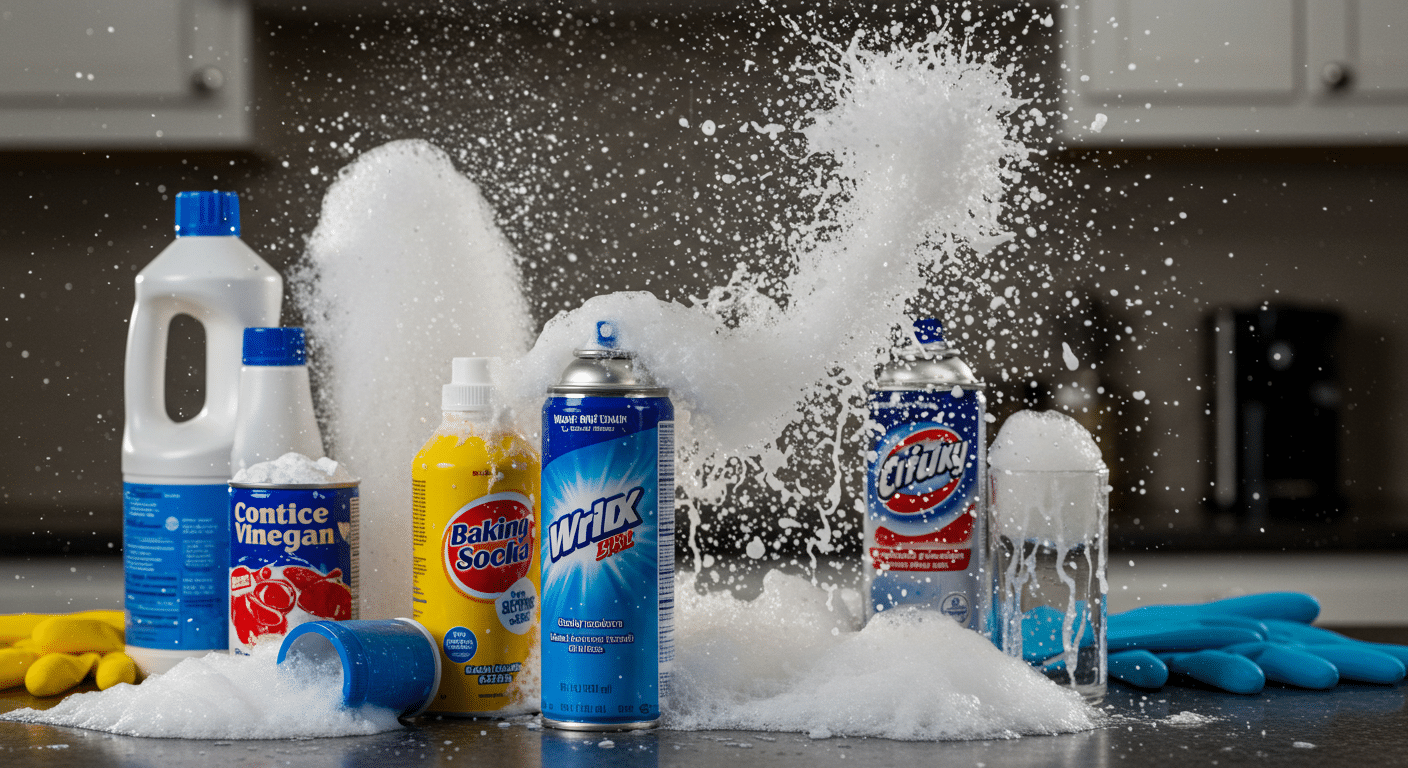Estimated reading time: 8 minutes
Key Takeaways
- Explosive reactions can often be created with common household products.
- It’s vital to **understand safety** protocols when conducting any chemical experiments.
- Chemistry in everyday life reveals that even simple mixtures have complex reactions.
- Highlighting the differences between dramatic reactions versus dangerous ones can promote better awareness.
- Social media platforms, such as TikTok, ignite curiosity and interest in chemistry through entertaining experiments.
Table of contents
- Understanding Explosive Reactions
- Common Household Products That Cause Explosions
- The Classic Volcano Experiment
- Exploring Water’s Unique Behavior
- Why Water Behaves Like an Alien Liquid
- Water’s Role in Explosive Reactions
- Fun with Glow-in-the-Dark Elements
- Glow-in-the-Dark Elements You Can Buy
- DIY Projects with Glow-in-the-Dark Elements
- Chemistry Behind Viral TikTok Experiments
- Popular TikTok Experiments
- Frequently Asked Questions
Explosive reactions in household products are more common than you might think. From the fizz of a soda to the eruption of a DIY volcano, chemistry plays a fascinating role in everyday life and in whole universe. These reactions often capture our imagination, especially when they go viral on platforms like TikTok. But there’s more to these explosions than just entertainment—there’s a wealth of science to explore. In this blog post, we’ll dive into the chemistry behind viral TikTok experiments, the surprising behavior of everyday substances, and how you can safely experiment with these principles at home.
Understanding Explosive Reactions
Explosive reactions are chemical processes that produce gas and heat rapidly, leading to a sudden release of energy. When certain household products are mixed, they can create these explosive reactions, often with surprising results.
Common Household Products That Cause Explosions
- Vinegar and Baking Soda:
When mixed, these two pantry staples produce carbon dioxide gas, leading to bubbling and potential overflow. This reaction is the basis for classic science experiments, like the erupting volcano. While not truly explosive, the rapid release of gas can create a dramatic effect. - Bleach and Ammonia:
Mixing bleach and ammonia is dangerous and creates toxic chloramine vapors. This combination is not safe to experiment with and should be avoided entirely.
The Classic Volcano Experiment
One of the most iconic examples of explosive reactions is the homemade volcano. Using a simple mixture of baking soda and vinegar, kids and adults alike can create a miniature eruption. The chemical reaction between the acid (vinegar) and base (baking soda) produces carbon dioxide gas, which builds pressure until it erupts.
For more details on this reaction, check out this resource: PrimoStats.
Exploring Water’s Unique Behavior
Water is often referred to as “an alien liquid” due to its unique properties, which play a significant role in many chemical reactions.
Why Water Behaves Like an Alien Liquid
- Polarity:
Water molecules are polar, meaning they have a positive charge on one end (hydrogen) and a negative charge on the other (oxygen). This property makes water an excellent solvent, capable of dissolving a wide variety of substances. - Hydrogen Bonding:
Water molecules form weak bonds with each other, known as hydrogen bonds. These bonds are responsible for many of water’s unique properties, including its high boiling point and surface tension.
Water’s Role in Explosive Reactions
Water’s polarity and hydrogen bonding make it a key player in explosive reactions. For example, when water is added to certain chemicals, it can accelerate reactions by dissolving reactants and allowing them to interact more freely.
Learn more about water’s unique properties here: Discover PhDs.
Fun with Glow-in-the-Dark Elements
Glow-in-the-dark elements can add an extra level of excitement to your home experiments. While some glow-in-the-dark products are best left to professionals, others are safe for amateur scientists.
Glow-in-the-Dark Elements You Can Buy
- Strontium Aluminate:
This is one of the most common glow-in-the-dark compounds. It’s non-toxic and can be found in many consumer products, such as glow sticks and paint. - Zinc Sulfide:
Another popular glow-in-the-dark material, zinc sulfide is often used in glow-in-the-dark toys and decorations.
DIY Projects with Glow-in-the-Dark Elements
- Glowing Slime:
Mix glue, water, and strontium aluminate powder to create a slimy substance that glows in the dark. - Glowing Paint:
Use strontium aluminate to make paint that glows after exposure to light.
For more details on glow-in-the-dark materials, visit: Austin Copywriter.
Chemistry Behind Viral TikTok Experiments
TikTok has become a hotbed for chemistry enthusiasts, with explosive reactions and colorful experiments gaining millions of views. But what makes these experiments so popular?
Popular TikTok Experiments
- Diet Coke and Mentos:
Dropping Mentos into a bottle of Diet Coke creates a rapid release of carbon dioxide, causing the soda to fizz violently. This reaction is similar to the volcano experiment but on a much larger scale. - The Elephant Toothpaste:
This colorful explosion occurs when hydrogen peroxide reacts with yeast or potassium iodide, creating a foamy eruption that resembles a giant toothpaste tube exploding.
Frequently Asked Questions
1. Are all explosive reactions dangerous?
While not all explosive reactions are dangerous, caution should always be exercised. Many classic reactions, like vinegar and baking soda, are safe, while others, like bleach and ammonia, can be deadly.
2. Can I experiment with these reactions at home?
Yes, many household chemical reactions can be safely performed at home. Always follow safety procedures and guidelines to avoid accidents.
3. What should I do if I accidentally mix dangerous chemicals?
If you suspect you have mixed dangerous chemicals, evacuate the area immediately and call for help. Do not try to clean it up yourself.
4. Why are TikTok experiments so popular?
TikTok experiments are popular because they are visually engaging and often produce exciting results that capture viewers’ attention. They also make learning about chemistry fun!
5. How can I learn more about chemistry?
There are many resources available online, including tutorials, articles, and community college courses that can help deepen your understanding of chemistry.
